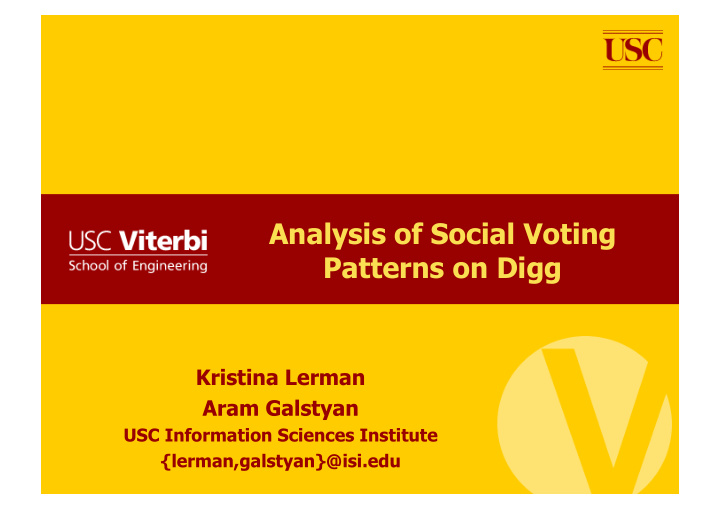



Analysis of Social Voting Patterns on Digg Kristina Lerman Aram Galstyan USC Information Sciences Institute {lerman,galstyan}@isi.edu
Content, content everywhere and not a drop to read • Explosion of user-generated content • 2G/day of “authored” content • 10-15G/day of user generated content • How do users/consumers find relevant content? • How do producers promote their content to potential consumers?
Social networks for promoting content • Viral or word-of-mouth marketing • Exploit social interactions between users to promote content • But, does it really work? • Previous empirical studies have conflicting results • Study showed popularity of albums did affect user’s choice of what music to listen to [Salganik et al., 2006] • Study showed recommendation might not lead to new purchases on Amazon [Leskovec, Adamic & Huberman, 2006] • Showed sensitivity to type and price of products
In this work • Do those results apply to free content? • How do social networks affect spread of free content? • Empirical study on social news aggregator Digg
Social news aggregator Digg • Users submit and moderate news stories • Digg automatically promotes stories for the front page • Digg allows social networking • Users can add other users as Friends • This results in a directed social network • Friends of user A are everyone A is watching • Fans of A are all users who are watching A
Lifecycle of a story 1. User submits a story to the Upcoming Stories queue 2. Other users vote on (digg) the story 3. When the story accumulates enough votes (diggs>50), it is promoted to the Front page 4. The Friends Interface lets users can see 1. Stories friends submitted 2. Stories friends voted on, …
How the Friends Interface works ‘ see stories my ‘ see stories my friends submitted’ friends dugg’
Research questions • What are the patterns of “vote diffusion” on the Digg network? • Can these patterns in early dynamics predict story’s eventual popularity?
Digg datasets • Stories Collected by scraping Digg … now available through the API • ~200 stories promoted to the Front page on 6/30/2006 • ~900 newly submitted stories (not yet promoted) on 6/30/2006 • For each story • Submitter’s id • Time-ordered votes the story received • Ids of the users who voted on the story • Social networks • Friends: outgoing links A B := B is a friend of A • Fans: incoming links A B := A is a fan of B • Enables to reconstruct the diffusion process
Dynamics of votes story “interestingness” 2500 2000 number of votes (diggs) 1500 1000 500 0 0 1000 2000 3000 4000 5000 time (min) • Shape of the curves (votes vs time) is qualitatively similar • Large spread in the final number of votes • Implicitly defines the “interestingness”, or popularity, of a story
Distribution of votes not interesting Interesting (popular) Wu & Huberman, 2007 ~30,000 front page stories ~200 front page stories submitted in submitted in 2006 June 29-30, 2006
Dynamics of voting on Digg • Two main mechanisms for voting • Voting is influenced by intrinsic attributes of a story • E.g., some stories are more interesting and have more popular appeal than others • Voting is also impacted by social interactions (e.g, through the Friends Interface) • Diffusive spread on a network • We can not measure “interestingness”, but we can analyze the patterns of “social voting” • Can we use those patterns to predict the eventual popularity of a story?
Patterns of network spread
Patterns of network spread
Main Findings
Stories submitted by the same user <500 final votes >500 final votes <500 final votes >500 final votes
Popularity vs in-network votes Popularity vs the number of in-network votes out of first 6 first 6 votes 2000 final votes 1500 1000 500 0 in-network votes • The stories that become popular initially receive fewer in- network votes
The trend continues first 10 votes 2000 final votes 1500 1000 500 0 first 20 votes 2000 final votes 1500 1000 500 0 0 5 10 15 20 in-network votes
Classification: Training • Predict how popular the story will become based on how many in-network votes it receives within the first 10 votes • Decision tree classifier • Features v10 • v10: Number of in-network votes <=4 >4 within the first 10 votes • fans1: Number of fans of submitter yes(130/5) v10 • Story popularity >8 <=8 – Yes if > 500 votes – No if < 500 votes fans1 no(18/0) <=85 >85 no(29/13) yes(30/8)
Classification: Testing • Use the classifier to predict how popular stories will be based on the first 10 votes it received • Dataset v10 • 48 new stories submitted by top users <=4 >4 • Of these, 14 were promoted by Digg • Predictions yes(130/5) v10 • Correctly classified 36 stories (TP=4, TN=32) • 12 errors (FP=11, FN=1) >8 <=8 • Compared to Digg’s prediction • Digg predicted that 14 are interesting (by promoting them) fans1 no(18/0) • Digg prediction: 5 of 14 received more <=85 >85 than 500 votes – Digg prediction: Pr=0.36 no(29/13) yes(30/8) • Our prediction: 4 of 7 received more than 520 votes (Pr=0.57) • Prediction was made after 10 votes, as opposed to Digg’s 40+ votes
Summary • Social Web sites like Digg provide data for empirical study of collective user behavior • How do social networks impact the spread of content, ideas, products? • Findings for Digg • Patterns of voting spread on networks indicative of content quality • Those patterns enable early prediction of eventual popularity • Future work • More systematic and larger scale empirical studies • Agent-based computational and mathematical models of social voting on Diggs
Recommend
More recommend